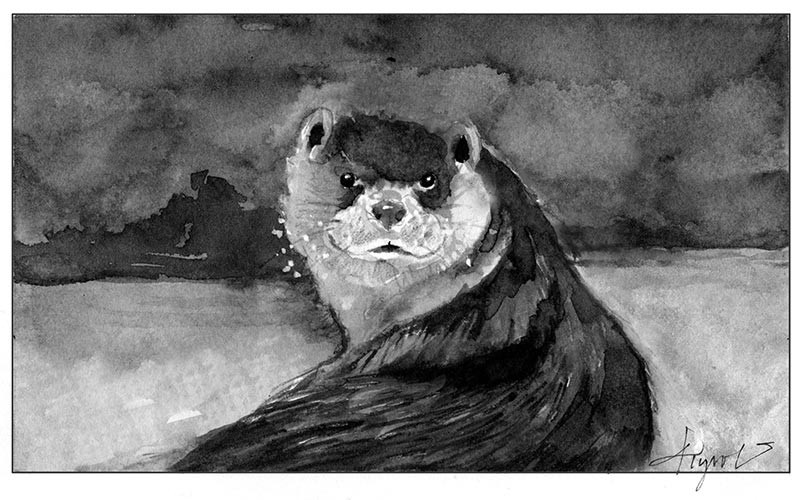
I have been living with an otter. He’s long and sleek, a graceful swimmer with an insatiable appetite for fish. At first he was just my boy, a chubby little toddler, happy to snuggle and follow his big sister around. But on the first snow fall of his second year of life, I watched him in his slick blue snowsuit climb up our steep hill, point his round little head down the hill and go, a daring headfirst belly slide. He repeated and repeated until at last he fell asleep at the bottom of his sliding trough, a smile on his red cheeked face. I knew then that I should have named him Lontra canadensis, instead of Liam Samuel.
River otters, by reputation, are playful and carefree. They toboggan down snowy hills into rivers. They gallivant while other animals labor. This is the image we’ve been given for centuries now. John James Audubon and John Bachman, in their 1851 The Viviparous Quadrupeds of North America Vol 2, described the otter’s “favorite sport as sliding … This sport they continue apparently with the keenest enjoyment until fatigue or hunger induces them to desist.” Other early naturalists contributed to this freewheeling image, including Ernest Thompson Seton and Henry Williamson. The generation of kids who grew up watching Wild Kingdom, heard Marlin Perkins describe otters as animals “devoted to fun.”
But is this reputation true? Is the river otter really spending its precious energy reserves on sliding shenanigans? My own observations suggest yes. Once, tracking two river otters in deep February snow, I came upon a spot where the bounding tracks went up and a wide trough came down; this pattern repeated again and again.
I lay at the top of the hill on my belly. My ungloved hand touched the wide groove where the otters’ own silvery bellies had left their mark. I wanted a small piece of this to sink into my skin. In my slippery winter coat, I slid down the hill head first, leaving my mark and giving proof to the otters that I knew how to play, too.
According to a study published in 2005 in the Northeastern Naturalist, entitled “Sliding Behavior in Nearctic River Otters: Locomotion or Play” by Dr. Thomas L. Serfass, there is scientific evidence that river otters are sliding for something more than just efficient motion. Using camera and video traps in a remote area of Pennsylvania, Dr. Serfass and his team captured video of three wild otters visiting a regularly used latrine site along the shoreline of a river. Out of the five minutes and 49 seconds of video, the otters were seen sliding down a snow covered rock 16 times. Dr. Serfass concluded, “Although river otters use sliding for locomotion, our observation of three river otters repeatedly sliding down an incline suggests that in some cases sliding is also a form of play behavior.”
While otters may indeed by playful, it doesn’t follow that their activity is wasteful. As in other mammals, including humans, play can serve a variety of useful purposes. Among young animals, it’s often a way to learn and practice certain skills, or establish social status in a group.
Once while hiking along the edge of a remote pond in New Hampshire’s north woods, I heard chirping and saw a mother otter and her three kits, their nut-brown heads dipping up and down in the water. I watched them watching me, all of us seemingly curious about one another. Long whiskers above their dark eyes were raised like unruly eyebrows. Their heads were compact, with little ear nubs and short muzzles that were encircled by long drooping whiskers. The otters dove and resurfaced many times near my rocky perch. The young otters chased one another in the water, rolling and wrestling, the water bubbling around them in a swirl. I saw their sleek streamlined bodies roll across the top of the water. I occasionally caught a glimpse of their silver underbellies and long tapered tails. I recognized their behavior. I’ve seen it in my own kits. It was play.
My son is now 15. He still loves to slide and fish. I would describe him as Ernest Thompson Seton once described an otter: “joyful, keen and fearless.” He’s had ample time to play and I hope he never stops. As for the otters, long may they slide.


Discussion *